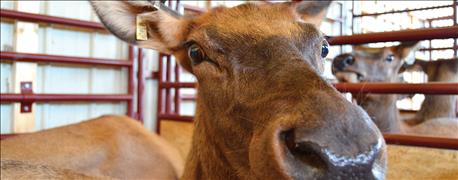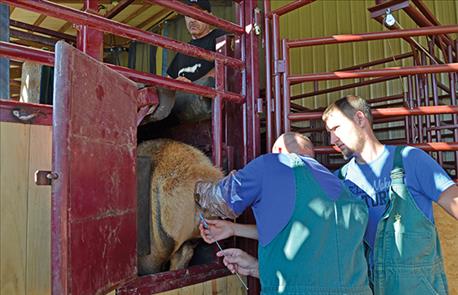
Bill Mayes stands atop a platform roughly 3 feet off the ground. He maneuvers the black hydraulic levers, opening the livestock handling chute. He waits patiently as a fellow farmer pushes the cow up. But this is not your typical cow, nor your traditional cattle chute. Passing through the gate is a female elk.

GENTLE CREATURES: Bill Mayes of Lentner says elk have a gentle, calm demeanor. He says raising elk keeps him tied to agriculture, the land and outdoor recreation.
It is artificial insemination time on a hot September day at Mayes Elk Farm, near Lentner. In this area of north-central Missouri, where row crops, cattle and hogs are the mainstay, a visit to the Mayes farm might seem out of the ordinary. But despite the differences in the animal Mayes is working this day, he finds that raising elk is much like raising cattle. It requires good production practices, good facilities and a steady market.
Breeding better elk
Mayes is using semen from known bulls in the industry. He flips through a catalog, pointing out the ones that will work in his operation, like Styx. At 4 years old, Styx officially cut 50.22 pounds of velvet, winning the 2013 North American Elk Breeders Association International Antler Competition — and is the heaviest officially weighed 4-year-old on record.
“Plus, he is known for throwing big calves,” Mayes says.
Mac Wilt, a veterinarian with Paris Veterinary Clinic, with his grandson Jacob Major, is coordinating the semen straws held in a nearby semen tank with the correct cow. This is the only elk farm Wilt works with. While the semen tank, straws and process are similar to artificially inseminating a beef or dairy cow, Wilt says with elk, everything is on a grander scale.

MARKET EXISTS: Bill Mayes says the elk industry has more domestic demand for meat, breeding stock and antlers than U.S. farmers are currently providing.
As the cow steps into the chute, Mayes eases the lever forward, gently squeezing her sides to keep her in the chute. He stops for a moment, pulls back the lever and waits for the cow’s head to pop up between two large black pads. Unlike a cattle chute, there is no head gate; the animals are just too large. So, the chutes are equipped with neck pads that run the entire length of the inside chute. The elk cow’s head must be squeezed above the pads before Wilt can go to work.
“You are just dealing with a lot larger animal,” he says. Once secured, the cow backs up to an access panel. Only the rear of the animal is visible. The gate has a guard that allows Wilt to work without being kicked.
Within a couple of minutes, Wilt finishes the AI process, Mayes releases the lever, and the cow strolls out. “They are relatively calm,” Mayes notes.

BREEDING WORK: Bill Mayes looks on from above the chute as Paris Veterinary Clinic veterinarian Mac Wilt and his grandson Jacob Major finish artificially inseminating an elk cow. The chute is designed to handle larger animals like elk.
Learning a new venture
This is the first time Mayes has artificially inseminated elk cows on his farm. The former white-tailed deer farmer turned to elk at the beginning of this year; increasing regulations and disease threats led to the change. “I have been around animals all of my life,” Mayes says. “I just had to have something to walk out of my door and look at in my pastures.”
He grew up raising beef cows and sheep. But his love of the outdoors and hunting spurred an interest in raising “unconventional” animals on his Shelby County farm.
He now owns 20 elk cows, but plans to increase that number to 80 or 90 head in the near future. As with cattle, Mayes relies on rotational grazing for feeding his herd. By nature, elk are browsers, he notes. But the system requires a slightly different approach.
Currently, Mayes has 14 acres of 8-foot, heavy-duty high fence. “It is a capital-intensive business,” he explains. Fencing alone runs about $15,000 per mile. When his expansion is complete, Mayes will have 35 acres under high fence.
Gates between the fescue pastures are taller and heavier. They must be able to keep the cows from returning to the previous pasture, and they serve as a divider between bulls and cows.
2 nutrition programs
Mayes supplements grazing with a complete feed. “But when the grass is fresh, they will leave the feed every time.”
When feeding the bull and heifer calves, Mayes divides the groups and offers two different nutritional programs. “There has to be proper nutrition for antler growth,” he says. He says elk grow all of their antlers in 100 days, so the males need ample food to grow antlers weighing 20 to 30 pounds in a short time period. Mayes feeds up to 20 pounds per animal per day during the growth stage to supply the calcium and phosphorus needs; this maximizes antler growth and maintains body condition. Elk shed their antlers each year.
Elk also need ample water supply. Mayes installed automatic waterers across his farm.
Raising elk where cattle once grazed works for Mayes. “I enjoy walking outside and seeing them in the pastures,” he says. “There is just something majestic about them.”
About the Author(s)
You May Also Like






